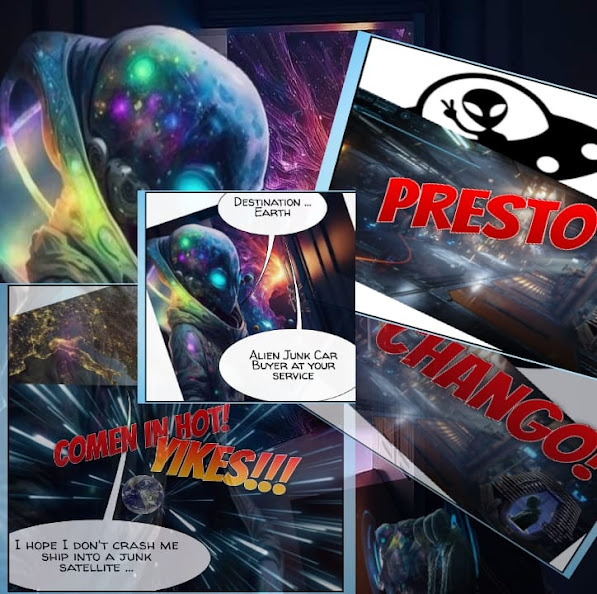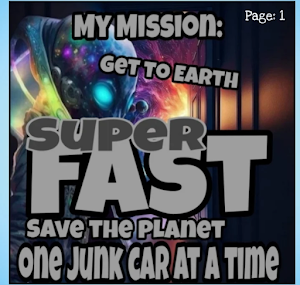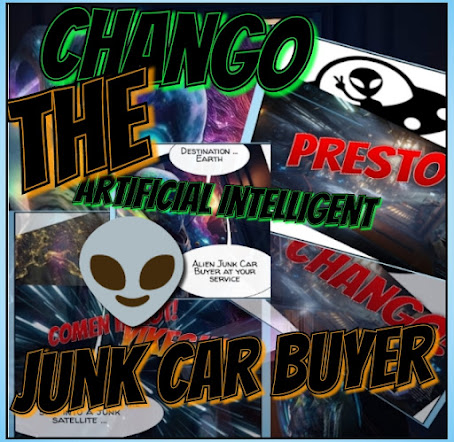Chapter 4: Space Invaders
Chapter 4: Space Invaders
Notes: The following science fiction prose introduces a real life topic discussion of carefully comparing current vehicle recycling methods, practices, and laws in Europe and the United States of America and in doing so the author, Gary Jennings, is suggesting the development of new processes so to recover 99% of recycled vehicle materials by combining both European and American automobile recycling methods on an global level.
Space Invaders
***
Elon Musk has been grappling with the newfound mental powers gifted to him through Chango's implant and the guidance of Xenon Prime. However, he now faces the challenge of trying to slow down his thoughts and focus on a particular idea. In frustration, Elon likens it to being ADHD. Despite the difficulties, Elon discovers that he has the ability to control the movements of objects using his mind. As he concentrates on moving a clipboard in the laboratory, it suddenly falls to the floor. Meanwhile, Chango and Samantha have been busy buying two cars in Fishers, Indiana, and are en route to Chango's Junkyard located on an asteroid close to Earth.
Just as the rattle from the fallen clipboard's echoe begins to fade Chango chimes in from his flying saucer, "Elon, you copy?"
"Yes. Trying to grasp all this data soaring through my brain. You ready for another load of satelitte material", Elon replied.
Chango then said yes, but I have some plans I drawn up on a new and better recycling method for automobiles I want to run buy you."
"Certainly, What is you have?', Elon stated.
Chango replied, "Well, by comparing current vehicle recycling methods, practices, and laws in Europe and the United States of America such as,vehicle recycling is an essential practice that helps to reduce waste and conserve natural resources. The process of recycling a vehicle involves the proper disposal of the end-of-life vehicles (ELVs) and the recycling of their components and materials. In both Europe and the United States, there are laws and regulations in place that require the proper disposal of ELVs and encourage the recycling of their components and materials.
In Europe, the ELV Directive was adopted in 2000, which requires all member states to establish systems for the collection and treatment of ELVs. Under this directive, ELVs must be properly depolluted and dismantled before their components and materials can be recycled. The directive also sets targets for the reuse and recycling of ELVs and requires that at least 85% of the vehicle's weight be recovered or reused.
In addition to the ELV Directive, European countries also have laws and regulations in place that govern the collection, storage, and transport of scrap metal. For example, in the UK, the Scrap Metal Dealers Act requires all scrap metal dealers to be licensed and prohibits cash transactions for the sale of scrap metal.
One of the most significant differences between the United States and Europe when it comes to vehicle recycling is the way ELVs are treated. In Europe, ELVs must be depolluted and dismantled before they are recycled. This is done to ensure that any hazardous materials, such as mercury, lead, and cadmium, are removed from the vehicle before it is processed. This makes the process of recycling a vehicle much safer and more environmentally friendly. In the United States, ELVs are typically shredded before they are recycled. While this method is efficient, it does not allow for the removal of hazardous materials before the vehicle is processed.
In terms of vehicle recycling methods, many European countries use a process called "shredding and sorting". This involves shredding the ELV into small pieces and then using a variety of sorting techniques, such as magnets and air separators, to separate the different materials. This method is highly efficient and can recover up to 95% of the vehicle's materials.
In contrast, the United States primarily uses a process called "shredding". This involves shredding the ELV into small pieces and then using magnets and other techniques to separate the different materials. While this method is efficient, it typically recovers less than 80% of the vehicle's materials.
To ensure that ELVs are disposed of and recycled properly, many states in the United States have laws that require the proper disposal of ELVs and encourage the recycling of their components and materials. However, there is no federal law that specifically governs ELV recycling in the United States.
Like in Europe, the United States also has laws and regulations in place that govern the collection, storage, and transport of scrap metal. However, these laws vary widely from state to state.
Overall, while there are similarities in the laws and practices related to vehicle recycling in Europe and the United States, there are also some key differences. European countries have more stringent regulations in place, which have led to more efficient recycling methods and higher material recovery rates. In the United States, there is more variation in the laws and practices related to vehicle recycling, which can make it more difficult to ensure proper disposal and recycling of ELVs.
In recent years, there has been a growing awareness of the importance of vehicle recycling and its impact on the environment. As a result, both Europe and the United States have seen increased efforts to improve their vehicle recycling methods, practices, and laws. For example, in 2018, the European Commission adopted a new ELV Directive, which aims to increase the reuse
By comparing both methods I have a process in which will allow for 99% of vehicle recycling materials to be used."
"Really! That is interesting. Please, tell me more of this process!" Elon excitedly said.
Chango continued to explain, " By combining both traditional vehicle recycling methods and advanced metal collecting and separating practices can recover up to 99% of a vehicle's materials:
When a vehicle is brought to a recycling facility, the traditional method involves first draining all the fluids from the vehicle, such as gasoline, oil, and coolant. The recyclers then remove the reusable parts from the vehicle, such as the engine, transmission, and tires, which can be refurbished and sold. After this, the remaining metal frame of the vehicle is crushed and shredded into small pieces.
These shredded pieces of metal then undergo advanced metal collecting and separating practices, such as magnetic separation, eddy current separation, and air classification. Magnetic separation uses powerful magnets to extract ferrous metals, such as iron and steel, from the shredded material. Eddy current separation uses electromagnetic induction to separate non-ferrous metals, such as aluminum and copper, from the shredded material. Air classification uses air to separate lighter materials, such as plastics and foam, from heavier materials, such as metal.
By combining these methods, up to 99% of a vehicle's materials can be recovered. The traditional method recovers the reusable parts and the metal frame, while the advanced metal collecting and separating practices recover the remaining metals from the shredded material. The recovered metals can then be sold to metal processors, who will melt them down and use them to make new products.
In addition to recovering metals, vehicle recycling also recovers other materials, such as glass and plastics, which can be used to make new products. By combining traditional vehicle recycling methods with advanced metal collecting and separating practices, we can recover a significant amount of valuable resources from end-of-life vehicles and reduce the need for new mining and manufacturing processes."
Elon replied, " Fascinating. Abolutle fascinating. There does exist a lot of obsicles in which will lay aheah, such as: Creating an international change in vehicle recycling methods and practices is not an easy task, and several difficulties may arise in the process. Here are some of the challenges that may arise:
Varying Laws and Regulations: Different countries have varying laws and regulations regarding vehicle recycling, which can make it difficult to create a standardized global approach. For example, some countries may have stricter environmental regulations than others, which can impact the methods used for recycling.
Lack of Infrastructure: Some countries may not have the necessary infrastructure and technology to implement advanced metal collecting and separating practices. This can be due to several reasons, such as lack of funding or a lack of trained personnel.
Cost: Implementing advanced metal collecting and separating practices can be expensive, and not all countries may be able to afford the costs associated with it. This can lead to a disparity in the quality of vehicle recycling practices between developed and developing countries.
Resistance to Change: Some recycling facilities may be resistant to changing their current methods and adopting new practices. This can be due to several reasons, such as lack of knowledge or a belief that their current methods are effective.
Stakeholder Collaboration: Coordinating efforts among stakeholders, such as governments, recyclers, and metal processors, can be challenging. Collaboration is necessary to create a standardized global approach to vehicle recycling.
Despite these difficulties, creating an international change in vehicle recycling methods and practices is essential to reduce the environmental impact of end-of-life vehicles and promote sustainability. Collaboration among stakeholders and the creation of incentives and funding for implementing advanced metal collecting and separating practices can help overcome these challenges and lead to a more sustainable approach to vehicle recycling globally.
Despite all such barriers, I believe you are on to something. You on the way here now?"
Chango answered, " Yes ... ", as the his flying saucer rocked back and fortth, throwing the craft momentararily out of control from a nearby explosion, breaing communicatin between himself and Elon.
***
Trinity sat in front of an elaborate satellite monitoring system, her eyes fixed on the screen as she watched Chango and Samantha leave Earth's atmosphere, heading towards the asteroid belt. The two Max Destruction goons were in the hotel room with her, their eyes nervously darting between Trinity and the satellite screens.
"Time to rock and roll, boys," Trinity said, a mischievous smile spreading across her face as she rose from her chair. The two goons looked at each other before quickly following behind her.
They exited the hotel and made their way to a black suburban with dark tinted windows waiting outside. Trinity jumped into the driver's seat, while the two goons took their places in the back, cocking their firearms and removing the safety switches.
Trinity sped towards the Space X launching pad, her foot heavy on the gas pedal. As they approached, gated and armed Space X guards came into view. Trinity didn't slow down. She pulled up to the guard shack, and the two goons opened fire, killing the guards without hesitation.
Once inside the complex, Trinity and her accomplices made their way to an experimental, super-fast Space X warp drive shuttle armed with rockets and lasers. Trinity quickly input the access codes she had obtained through her hacking skills, and the shuttle's hatch opened.
As they entered the shuttle, Trinity gave the rockets and lasers a quick once-over. The rockets were the latest in Space X technology, capable of achieving incredible speeds, while the lasers were equipped with the latest in targeting and tracking systems.
Without wasting any time, Trinity fired up the engines and took off into outer space in hot pursuit of Chango's flying saucer. The shuttle's engines roared as they soared through the emptiness of space, the rockets propelling them forward at an incredible speed.
As they closed in on Chango's flying saucer, Trinity armed the lasers and locked onto their target. She fired, the lasers blasting towards Chango's ship with incredible accuracy.
"Let's see how they like this," Trinity said with a smirk as the shuttle closed in on Chango and Samantha.
The chaos and destruction in space continued as Chango's flying saucer rocked back and forth, trying to maintain its stability in the midst of the explosion caused by the missile from the stolen Space X shuttle. Trinity was in the shuttle's cockpit, her eyes wide with fear as the red pulsing lights from Chang's flying saucer began to spin around in a fashion as to face the Space X spacecraft.
"Oh shit!" she exclaimed, her voice trembling.
One of the goons in the back of the ship chimed in, "I think we made it mad."
Chango remained focused, his hand on the controls. He knew the situation was dangerous, but he also knew that he had to act fast to prevent further damage. As he concentrated on the shuttle,preparing to launch a particle laser beam so to destroy the attacking space invader, a telepathic message from Elon Musk came through. Chango listened intently as Elon warned him about the potential consequences of destroying the shuttle.
"Do not destroy that ship!" Elon warned. "If it explodes, the armaments on that shuttle will create electromagnetic discharge that will knock out all the current satellites, killing four Russian astronauts caught in it's path. Use your tractor beam. It will shut down all of the shuttle's controls. You can then tow the shuttle here to the space station. We can then board the shuttle and take them into custody, locking them up in holding cells."
Chango nodded, acknowledging the message. "Got ya," he replied.
As the flying saucer traveled through space, Samantha asked who he was communicating with.
"Elon Musk," Chango replied. "Give me a few moments, and I will elaborate in greater detail. For the time being, brace yourself."
He locked onto the shuttle with the flying saucer's tractor beam and began to tow it towards the International Space Station.
The journey was bumpy, and the shuttle caused the flying saucer to jolt back and forth while Chango bumbled to himself, "Destroying these ugly satellites would have been a definite perk."
Despite his frustration, Chango remained focused on the task at hand. He knew that he had to get the shuttle to the space station without causing any further damage.
Finally, they arrived at the space station, and Chango used the tractor beam to dock the shuttle. Elon and his team greeted them as they boarded the shuttle and took the intruders into custody.
As they locked the intruders up in holding cells, Elon turned to Chango. "Thank you for your help," he said. "I knew I could count on you."
Chango smiled, "No problem. It was the right thing to do."
Elon nodded, "I owe you one."
Chango laughed, "How about you let me take a spin in one of those fancy Tesla's?"
Elon grinned, "Consider it done."
Chango and Samantha then headed back to the flying saucer, set course for his junkyard in outer space, relieved that the situation had been resolved without any casualties as he began focusing on his mission again to save planet Earth one junk car at a time.
Chango
- Chango: The Atrificial Intelligent Alien Junk Car Buyer and the Nexus of Technology, Society, and the Environment
- Brought to you by:
Cash for Cars of Indianapolis, IN - 3127 Shelby St
Indianapolis, IN 46227 - (260) 568-0174
- https://www.cashforrunningcarstrucksvans.com/




Comments